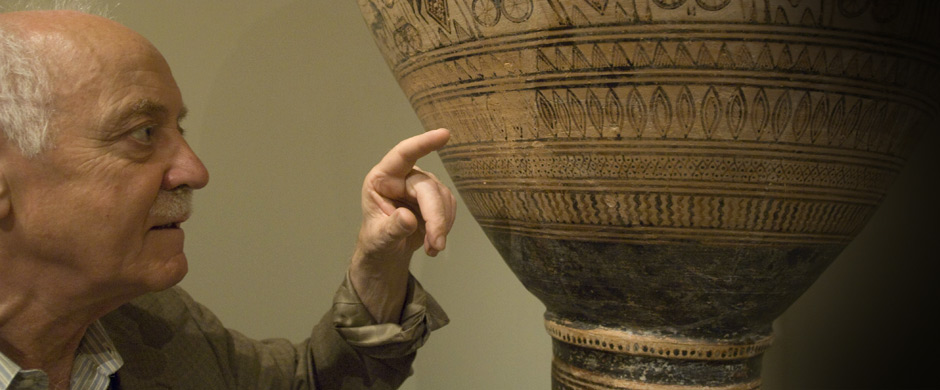I see a divide in my CV: the years before and the years after entering this country and teaching at the IFA. I see those before my time at the IFA as preparatory, with goals pursued as offered. First there was my dissertation on fourth-century Athenian ceramics that later was to earn me a one-year travel grant from the German Archaeological Institute to visit all of the Near East and Egypt, at peace at that time, before the Seven Days War. That, and the campaigns in Olympia (1958-59) and Samos (1961-66), led to work on the Greek-Near Eastern connections. One later upshot of this work was the conference Greece Between East and West at the Institute, with Chester G. Starr presiding. I recently returned once more to the topic of orientalizing, taking the Bronze Age into account (“Liturgy” in The Adventure of the Illustrious Scholar: Papers Presented to Oscar White Muscarella, Elizabeth Simpson, ed., in press). To return to earlier days, the “international” wood found on Samos (1965-67) that I managed to conserve became famous. Samos finds and monuments in general provided new insights into the world inhabited and visited by Greeks between the tenth and sixth centuries BC, from Babylon to Spain, developed in the evidence that I found and subsequently published.
While Assistant Curator in charge of restoration at the Glyptothek in Munich (1962-65), I was handed some of the best sculpture there is: the Aegina pediments. Mine was groundbreaking work because there were no models for what we were doing. We became the school for others. A by-product: I spotted and published one of the few original Greek masterpieces actually found in Rome, the sculpture of a wounded bitch, a rare class of funerary art.
Coming to this country in 1969, I lost many of my home contacts. Nevertheless, I was commissioned to write a book-length contribution to the Archaeologia Homerica, a scholarly series, on Handel (in German), which gave me the opportunity to think about the subject. At the time, Bronze Age studies were newly inspired by works such as Renfrew’s Emergence (1972), Muhly’s Copper and Tin (1973), and Ventris and Chadwick’s Documents in Mycenaean Greek (1973). Reading them guided me to my own conclusions that Greek history did not begin with Homer but with Crete. The problem was how to write history with archaeology almost being the only source for information. Not quite “pre-historical” perhaps, as Greek identity is well known from later times and could be retro-jected. But my first question was, is it possible to arrive at a psychopathology of Bronze Age leaders? Asking “What are heroes?” is likewise instructive. Ruins become telling evidence for such questions.
Present Research and Writing
Crete was the begetter of Greek kingdoms and, by means of aesthetic influence, of Classical Greek art as well. What could be called an otherworldly glow characterizing Greek art (in itself a topic to be discussed) had developed in Crete and was transmitted to Greece. Concluding that much is in the art historian’s domain. Asking how it is that all this was retained and strikingly resurfaced later is another matter, a problem of “long-term memory” for which colleagues from other disciplines may have an answer. My goal is to get this discussion underway. I have previously outlined my idea of Greek Bronze Age kingship (in “Mycenaean Kingship - A Speculative View” from Commerce and Monetary Systems in the Ancient World,2004), arguing that there was the rule of the king, and there was a people’s government-in-waiting. “Folk art” – my interpretation – may be read as evidence of these internal differences, manifesting a proto-democratic undercurrent; fittingly Greek, of course. The projected title for publication of this research, uncertain whether as an article or book, is “The Cretan Impact.”
Teaching at the IFA
I have never focused on art per se, but on the political and economic strength of entities (such as Phoenicians) and phases (such as early Greek Democracy), to which art can be seen as bearing witness. Intending to go forward from antiquity to the formation of Europe, I have taught courses on Rome north of the Alps: on the arc from Hallstatt/ La Tene to the three Gauls and the Merovingians. This is bed-rock Europe, familiar places where ongoing reasons for their growth, decay, and recovery are traceable. The need for research on this longue durée or transition is obvious. But rarely will one find resources capable of readily supporting such offerings as the Institute’s library. With regard to the students’ response to these topics: the most positive yet. I have taught numerous courses – lectures and seminars – on ancient Greek and Cretan art – recently the NYU undergraduate programs as well as at the Institute (2007, 2011, 2015).
IFA – Director of Master Studies, 2012 – 2014
The Director of Master Studies is a meaningful addition to the teaching program. The role required one-on-one meetings with students that almost invariably turned into tutorials where, especially in relation to MA theses, a connection was sought and made between the students’ preparation and interests and potential topics. I learned a great deal about students’ backgrounds and sometimes their problems. Not even seminars offer such an opportunity for getting to know students, and especially for shoring up self-confidence in meaningful ways. For me, it was a time when I felt I was doing what is an essential part of education, to give students reasons to believe in personal satisfaction as part of their formation.





